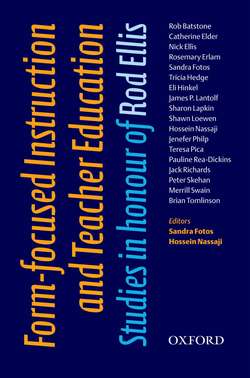Form-Focused Instruction and Teacher Education

Реклама. ООО «ЛитРес», ИНН: 7719571260.
Оглавление
Hossein Nassaji. Form-Focused Instruction and Teacher Education
Introduction
Part One. Theoretical issues of focus on form
1. Issues in form-focused instruction and teacher education
2. The weak interface, consciousness, and form-focused instruction: mind the doors
3. Conceptual knowledge and instructed second language learning: a sociocultural perspective
4. Task research and language teaching: reciprocal relationships
Part Two. Focus on form and classroom practices
5. The distributed nature of second language learning: Neil’s perspective12
6. Recontextualizing focus on form
7. The prior and subsequent use of forms targeted in incidental focus on form
8. Reactive focus on form through negotiation on learners’ written errors15
9. Form-focused instruction and output for second language writing gains17
Part Three. Focus on form and teacher education
10. Materials development and research: towards a form-focused perspective22
11. Time, teachers, and tasks in focus on form instruction
12. Using form-focused discovery approaches
13. Learning or measuring? Exploring teacher decision-making in planning for classroom-based language assessment
14. Learning through the looking glass: teacher response to form-focused feedback on writing
15. Explicit language knowledge and focus on form: options and obstacles for TESOL teacher trainees27
Glossary of acronyms
Notes on the contributors
Bibliography
Отрывок из книги
THE EDITORS, AUTHORS, AND OXFORD UNIVERSITY PRESS are pleased to publish this book in honour of Rod Ellis for his outstanding contribution to the field of second language teaching and learning.
THE EDITORS AND THE PUBLISHER would like to thank the authors for their excellent chapters, and are grateful to Allster Cumming, Henry Widdowson, and David Nunan for their helpful comments and suggestions. The editors would like to thank Laura Hawkes for her assistance.
.....
The third section, ‘Focus on form and teacher education’, integrates FFI with teacher education and practice. Chapter 10, ‘Materials development and research: towards a form-focused perspective’ by Jack Richards, discusses research and theory in materials development, including the writer’s goals, the focus of the materials, and the syllabus. Richards suggests that development of successful teaching material is not dependent on research but rather on how the material is received by teachers and students, and whether it meets their needs.
Chapter 11, ‘Time, teachers, and tasks in focus on form instruction’ by Teresa Pica, addresses time as a factor in teachers’ selection of target forms, their decision when to focus attention on the forms, and their practices for form mastery. Recommendations are given for designing tasks which are consistent with FFI and curriculum requirements. Brian Tomlinson’s Chapter 12, ‘Using form-focused discovery approaches’, describes various types of discovery approaches and investigates teacher attitudes and adoption practices. The author’s experience of introducing discovery approaches to teachers around the world is presented, and suggestions are offered regarding the use of discovery approaches in the future.
.....